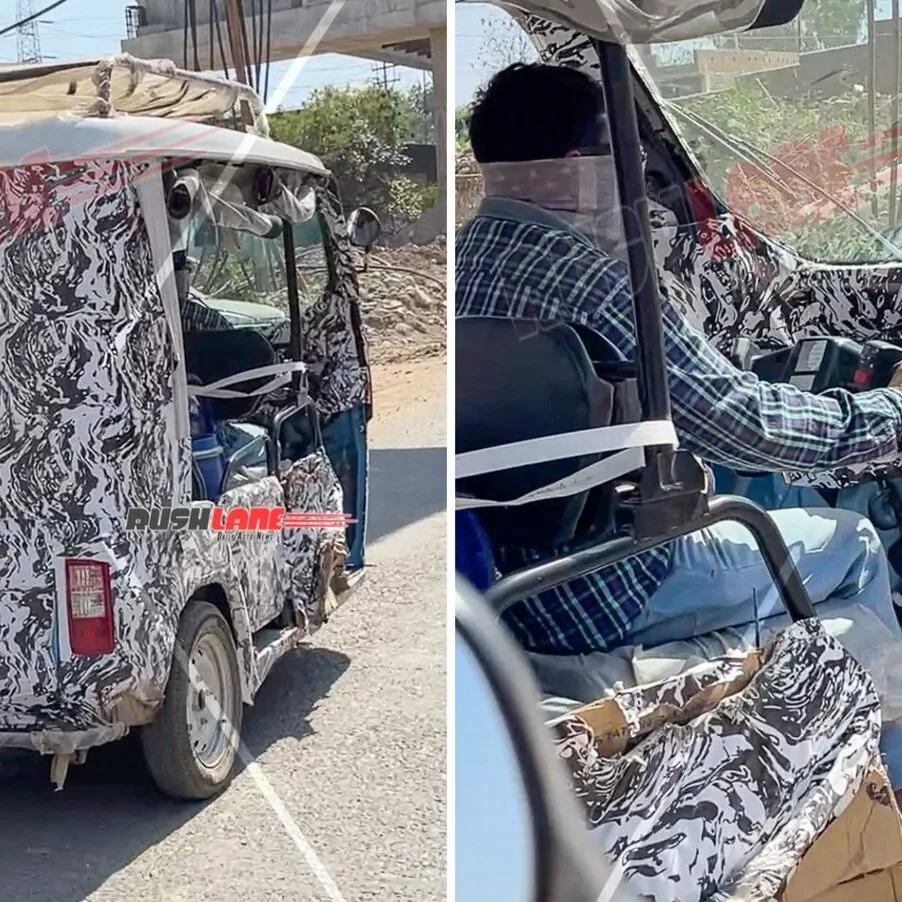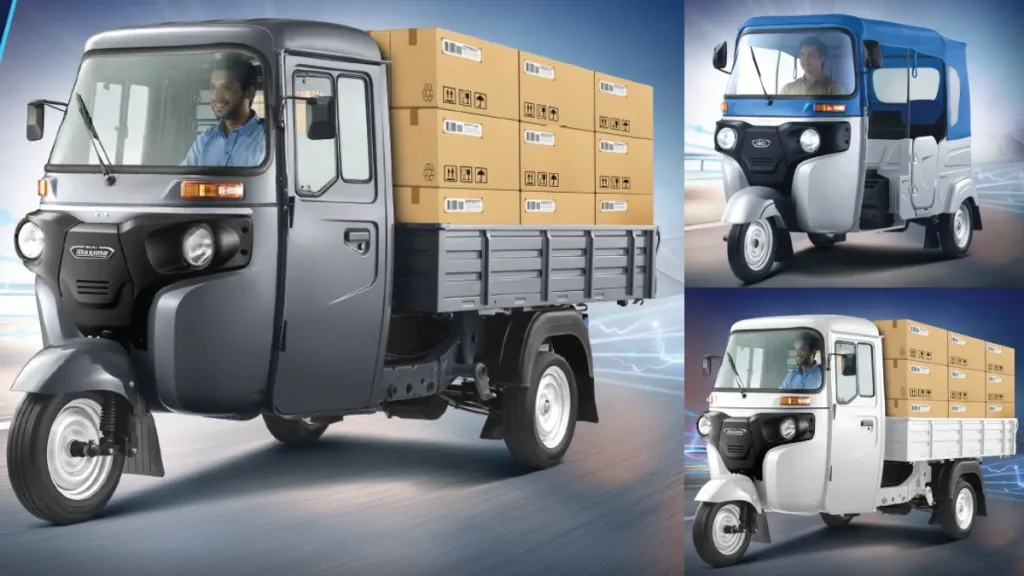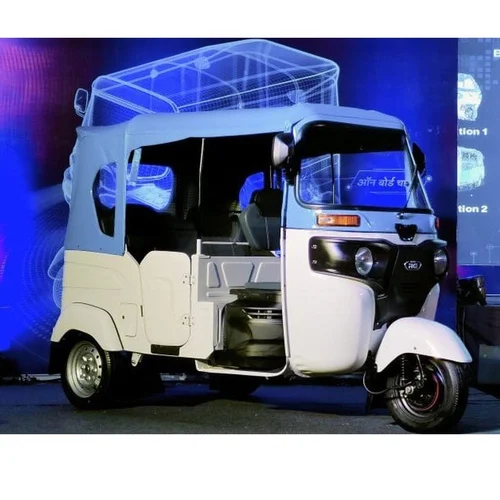A more affordable version of the Bajaj Electric Rickshaw was recently spotted undergoing testing in Jammu, signaling the company’s commitment to expanding its electric three-wheeler lineup. This development comes at a crucial time as India pushes toward sustainable transportation solutions that balance affordability with environmental benefits.
The bajaj electric rickshaw price starts at ₹3.76 lakh for the current RE E-TEC 9.0 model, making it a competitive option in the market. However, the newly spotted variant is expected to come with a more accessible price point, potentially revolutionizing the electric three-wheeler segment in India.
Table of Contents
Understanding the Bajaj Electric Rickshaw Price and Value Proposition

When evaluating the bajaj electric auto rickshaw price, it’s essential to consider both the upfront cost and long-term savings. The current flagship model, priced at ₹3.76 lakh (ex-showroom, New Delhi), represents Bajaj’s premium offering in the electric three-wheeler category.
The official bajaj electric auto rickshaw price may vary slightly depending on your location in India. Cities like Hyderabad, Mumbai, and other major urban centers might have different pricing due to local taxes and incentives.
What makes this investment worthwhile is the significant reduction in operating costs compared to conventional fuel-powered rickshaws. Drivers typically report savings of 60-70% on daily running expenses, allowing for faster recovery of the initial investment.
“I switched from a CNG auto to the Bajaj electric rickshaw last year, and my daily expenses have dropped from ₹600 to just ₹150,” says Ramesh Kumar, a rickshaw driver from Delhi. “The bajaj electric rickshaw price seemed high at first, but the savings made it worth it within months.”
Complete Bajaj Electric Auto Rickshaw Specifications
The bajaj electric auto rickshaw specifications include a powerful 4.5 kW motor with 36 Nm torque, providing smooth acceleration and comfortable cruising speeds. According to the official bajaj electric auto rickshaw specifications, it can reach speeds of up to 45 km/h, making it suitable for urban commuting.
Here’s a comprehensive breakdown of the technical specifications:
| Specification | Details |
|---|---|
| Battery | 8.9 kWh Lithium-ion Phosphate |
| Motor Output | 4.5 kW power with 36 Nm torque |
| Maximum Speed | 45 km/h |
| Range | 178 km per full charge |
| Charging Time | 4 hours 30 minutes (full charge), 3 hours (0-80%) |
| Gross Vehicle Weight | 708 kg |
| Wheelbase | 2274 mm |
| Tires | 120/80 R12 radial tubeless |
| Gradeability | 29% |
Drivers are impressed by the bajaj electric auto rickshaw specifications, particularly the 178 km range on a single charge, which eliminates range anxiety for daily urban operations. The 4.5-hour charging time fits conveniently into overnight charging routines, ensuring the vehicle is ready for a full day’s work.
Essential Bajaj Electric Rickshaw Features for Drivers and Passengers
The bajaj electric rickshaw features include regenerative braking and hill hold assist for enhanced safety, particularly valuable in India’s diverse terrain and traffic conditions. Among the most impressive bajaj electric rickshaw features is the two-speed automatic transmission, which optimizes performance and energy efficiency.
Key features that set the Bajaj electric three-wheeler apart include:
- Advanced Safety Systems
- Regenerative Braking System
- Hill Hold Assist
- IP67-rated Battery Pack (dust and water-resistant)
- Comfort & Convenience
- Well-cushioned seats
- Digital instrument cluster
- Spacious cabin design
- Provision for aftermarket audio systems
- Superior Suspension
- Twin shock absorbers (front)
- Independent trailing arm with helical spring (rear)
Drivers appreciate the practical bajaj electric rickshaw features like the digital instrument cluster that provides real-time information on battery status, range, and speed. The spacious cabin design offers comfort for both the driver and passengers, enhancing the overall experience.
The New Bajaj E-Rickshaw: Evolution of Three-Wheeler Transportation
The new bajaj e rickshaw model represents a significant advancement in electric three-wheeler technology, building on Bajaj’s decades of experience in the auto-rickshaw market. Drivers who switch to the bajaj e rickshaw report significant savings on operating costs, with many recovering their investment within 18-24 months of operation.
The bajaj e rickshaw features an IP67-rated battery pack that’s resistant to dust and water, addressing one of the primary concerns about electric vehicles in India’s diverse climate conditions. This durability factor has contributed significantly to the growing acceptance of electric rickshaws among commercial operators.
Bajaj Auto has shown remarkable growth in the electric three-wheeler segment, moving from 28th to 13th position in market rankings. The company achieved sales of 10,886 units in FY2024, demonstrating the increasing popularity of their electric offerings.
Comparing Bajaj Three Wheeler Options: Electric vs. Traditional

The bajaj three wheeler lineup now includes both traditional fuel-powered options and the newer electric variants. When comparing these options, several factors come into play:
| Feature | Bajaj RE E-TEC 9.0 (Electric) | Bajaj RE (CNG/LPG) |
|---|---|---|
| Initial Cost | ₹3.76 lakh | ₹2.50-2.80 lakh |
| Running Cost (per km) | ₹0.80-1.00 | ₹3.50-4.00 |
| Maintenance Cost (annual) | ₹5,000-8,000 | ₹15,000-20,000 |
| Range | 178 km per charge | 150-180 km per fill |
| Refueling/Recharging Time | 4.5 hours | 10-15 minutes |
| Environmental Impact | Zero emissions | Moderate emissions |
| Noise Level | Very low | Moderate to high |
While the bajaj three wheeler with traditional fuel options has a lower initial cost, the electric variant offers significantly reduced operating costs and environmental benefits. For drivers covering 100-150 km daily, the electric option typically becomes more economical within 1.5-2 years of operation.
Bajaj Electric Auto Price: Investment and Returns Analysis
The bajaj electric auto price reflects its position as a premium yet affordable option in the growing electric three-wheeler market. Customers should consider the long-term savings when evaluating the bajaj electric auto price, as the total cost of ownership over 5 years is typically 30-40% lower than conventional fuel alternatives.
Government subsidies and incentives further enhance the value proposition. Under various state and central government schemes, buyers can avail benefits ranging from ₹25,000 to ₹60,000, effectively reducing the bajaj electric auto price.
Financial institutions are also offering specialized loan products for electric commercial vehicles with lower interest rates and extended repayment periods, making the transition to electric more accessible for drivers.
Environmental Impact: Beyond the Economics
The Bajaj RE E-TEC 9.0 is contributing to the growth of eco-friendly transportation in India, with each vehicle potentially reducing CO2 emissions by 4-5 tonnes annually compared to conventional fuel alternatives.
The shift toward eco-friendly transportation in India is helping reduce urban pollution levels, particularly in densely populated cities where air quality has been a growing concern. Electric rickshaws produce zero tailpipe emissions and significantly reduce noise pollution, creating a more pleasant urban environment.
Studies suggest that the transition to electric three-wheelers could reduce CO2 emissions by 500-600 megatonnes annually across India, equivalent to removing 170-200 million petrol-powered cars from roads.
Market Competition and Positioning
The electric rickshaw market in India sold 490,274 units in FY2024, representing 77% of total electric three-wheeler sales. This market is currently fragmented with over 500 players, though major manufacturers are beginning to establish stronger positions.
When compared to its closest competitor, the Mahindra Treo Plus, the Bajaj RE E-TEC 9.0 offers:
| Feature | Bajaj RE E-TEC 9.0 | Mahindra Treo Plus |
|---|---|---|
| Price | ₹3.76 lakh | ₹3.69 lakh |
| Range | 178 km | 150 km |
| Motor Power | 4.5 kW | 8 kW |
| Top Speed | 45 km/h | 55 km/h |
| Battery | 8.9 kWh | 10.24 kWh |
While the Mahindra offers higher power output and top speed, the Bajaj counters with superior range and comparable pricing, making it particularly attractive for drivers who prioritize daily coverage over maximum speed.
The Future of Bajaj Electric Rickshaws

With the electric three-wheeler market projected to grow to 500,000 units in FY2025, Bajaj is well-positioned to capture a significant share with its expanding lineup. The newly spotted affordable variant undergoing testing in Jammu represents the company’s strategy to address different segments of the market.
Industry experts anticipate that the new variant could be priced 15-20% lower than the current model, potentially bringing the entry point closer to ₹3 lakh. This would significantly expand the addressable market, particularly in tier-2 and tier-3 cities where price sensitivity is higher.
The bajaj electric rickshaw reliability is backed by the company’s extensive testing and quality control processes. Many drivers report excellent bajaj electric rickshaw reliability even after years of daily use, further strengthening the brand’s position in the market.


